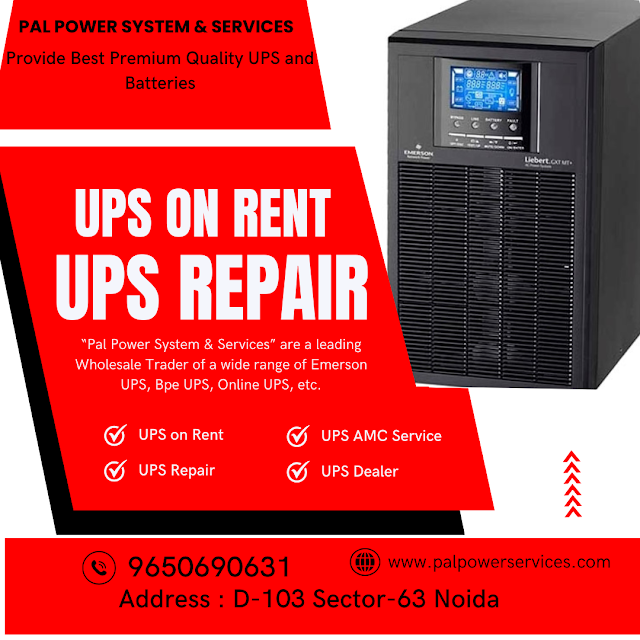UPS on Rent | UPS Repair | UPS Dealer
Pal Power System & Services
Call For Enquiry : 9650690631,9818756933
visit Website : https://palpowerservices.com/
UPS (Uninterruptible Power Supply) repair work involves troubleshooting, diagnosing, and fixing issues with UPS systems, which provide backup power during electrical outages or disruptions. A malfunctioning UPS can lead to downtime and potential damage to sensitive equipment, making prompt and efficient repairs crucial. Here’s an overview of UPS repair work:
1. Diagnosis and Troubleshooting
- Initial Assessment: Identify symptoms of failure (e.g., no output power, alarm signals, system failure to switch to battery mode).
- Visual Inspection: Check for visible signs of damage such as burnt components, leaks, or corrosion.
- Battery Testing: Test the batteries for voltage, capacity, and overall health since worn-out batteries are one of the most common causes of UPS failure.
- Circuit Board Check: Inspect the UPS's internal circuit boards for faults, damage, or component wear (capacitors, fuses, resistors, etc.).
- Cooling System Inspection: Ensure the cooling fans or heat sinks are functioning properly to prevent overheating, a common issue in older or heavily used UPS units.
2. Battery Replacement
- Battery Testing: If the UPS is failing to hold a charge, test the batteries to confirm whether they need replacement.
- Battery Sourcing: Ensure you source the correct replacement batteries according to the UPS model and specifications.
- Battery Disposal: Safely dispose of old batteries in compliance with local environmental regulations.
- Installation: Replace defective or old batteries and ensure the UPS is correctly configured to charge and maintain them.
3. Power Supply Unit (PSU) Repairs
- Rectifier Repair: The rectifier converts AC power to DC for charging the battery. If it's faulty, the UPS may not be able to charge the batteries properly.
- Inverter Repair: The inverter converts DC power back to AC for output. A malfunctioning inverter can cause the UPS to fail to provide backup power when needed.
- Surge Protection Repair: Inspect the surge protection components for any damage or wear and repair or replace them to protect sensitive equipment.
4. Software and Control Board Troubleshooting
- Microcontroller/Control Board: The UPS control board manages the system's operations, including switching between battery and main power. Faults in this area can cause incorrect functioning.
- Firmware Update: Ensure the firmware of the UPS is up to date. In some cases, firmware bugs can cause malfunctioning.
- Communication Ports: If the UPS has remote monitoring capabilities, test the communication ports (e.g., RS232, USB) for functionality.
5. Cooling System Repairs
- Fan Inspection: Inspect and clean the cooling fans or replace them if they are malfunctioning. Overheating is a common issue when cooling fans stop working.
- Airflow Check: Ensure that airflow through the UPS is not obstructed and that vents are clear of dust and debris.
6. Electrical Component Replacement
- Capacitors and Fuses: Inspect the capacitors and fuses, especially in older UPS systems, as they tend to wear out over time and may need to be replaced.
- Transformer Repair or Replacement: In cases where the transformer is damaged, it may need to be repaired or replaced.
7. UPS System Calibration and Testing
- Load Testing: After repairs, perform a load test to ensure that the UPS can handle the full load it is designed for.
- Runtime Testing: Test the UPS to ensure it provides sufficient backup power to connected equipment for the required time.
- Voltage Regulation Testing: Verify that the UPS is properly regulating voltage during normal operation and when switching to battery mode.
8. Preventive Maintenance
- Cleaning: Dust and dirt can cause overheating and system failures. Cleaning the UPS inside and out helps ensure optimal performance.
- Inspection Schedule: Establish a regular inspection schedule to identify potential issues before they cause failures.
- Firmware and Software Updates: Ensure that the system software and firmware are up to date to prevent bugs and improve overall reliability.
9. Testing Post-Repair
- Reconnection and Testing: Once repairs are completed, reconnect the UPS to the load, and perform several rounds of testing (load, battery, and operational).
- Event Logging: Check for any logged events or errors that might indicate underlying problems that still need addressing.
10. Replacement vs. Repair Decision
- If repairs are costly or if the UPS is outdated and inefficient, it may be more economical to replace the UPS rather than continuing with costly repairs.
Common UPS Problems That Require Repair
- Battery Failure: Batteries losing their ability to hold a charge or no longer providing enough power.
- Overheating: Insufficient cooling or excessive load can cause the UPS to overheat, leading to failures.
- Failure to Switch to Battery Mode: The UPS may not switch from mains to battery power during an outage.
- System Errors: Faults in the UPS’s internal electronics, including control boards or inverters.
- Power Surges: Damage to the UPS from sudden power surges or spikes in electrical supply.




Comments
Post a Comment